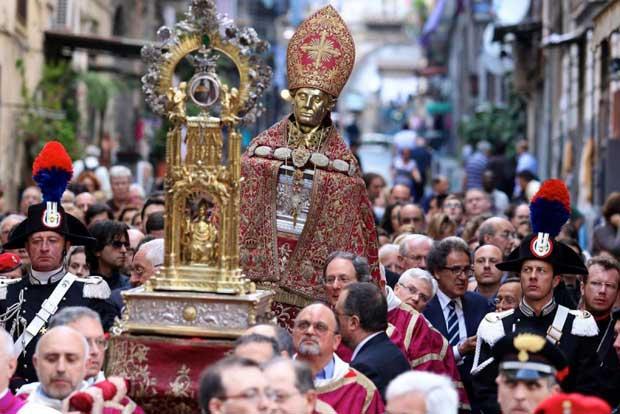Inspiration of comedy sketches, lottery numbers and children’s names, San Gennaro is celebrated every September 19 in Naples, where phials of his blood are worshipped. Gino De Blasio looks into the mystery of San Gennaro and how important he is to Italian Catholic devotees.
Few saints have had more cultural, social and religious impact than San Gennaro. For whilst Patron Saints of large cities are celebrated with a street festival in the area surrounding the church, San Gennaro is celebrated not only in Naples, but across the shores in New York's Little Italy, Los Angeles, San Diego and Las Vegas among others.
The Naples festival, which takes place every September 19th, honours the Saint with a deeply religious ceremony transitioning into the main event, the expected liquefaction of the blood of San Gennaro. Said to contain the saint's blood, the phial is held up and thoroughly examined; if it liquefies, a sign from God has been performed; the city rejoices in festivities for eight days and a few sighs of relief can be heard amongst the crowd. However, if the blood remains dried, there are no celebrations. Many Neapolitans believe that only ill can come from non-liquidity.
Of course, such an act has its skeptics. In 2006, members of the Italian Committee for the Investigation of the Paranormal (CICAP), which includes Nobel laureate Umberto Eco, were quick to dismiss this holy act. In a series of tests they set out to prove that the blood could indeed be a trick used as early as the mid-tenth century: a specific chemical can turn powder into liquid simply through the act of shaking. This skepticism is, however, looked upon unfavourably by a majority of the Neapolitan community. Their worship in the Patron of the city shows an unwavering faith and belief in a man whose act of martyrdom has transcended cultural and geographical boundaries.
The legend of San Gennaro begins during the 4th century. (We must note that there are different versions of the legend related to this historical figure). As Bishop of Naples, Gennaro embarked on a mission to save Christian friends from the hands of persecution as ordered by Emperor Diocletian.

The prefect of Nola, Timoteo, had Gennaro arrested and placed in jail. Tortured and beaten, Gennaro was sent to be eaten by wild bears in the Flavian Amphitheater of Pozzuoli, a sentence which was then to be changed due to fears of public disturbance. It was not, however, to be the sparing of him, since Timoteo would sentence Gennaro to be decapitated, thus making him a martyr.
It is said that at the time of the punishment, the groundskeepers, knowing the significance of this holy man, took it upon themselves to hide the body of Gennaro, taking phials of blood and storing them in sacred places so as to avoid capture by Roman troops.
Culturally, San Gennaro has been recounted into theatre spectacles, common street citation and even comedy sketches. For example, when Massimo Troisi and Lello Arena took to the stage in their 1977 comedy showpiece, Non Stop, they knew that the art to making people laugh wasn’t just the execution of the joke, but the circumstances in which it played. The Duomo of Naples being the imaginary backdrop seemed most appropriate.
Staring upwards, towards the ceiling, Troisi enters into a “discussion” with San Gennaro: “I shouldn’t have to speak, you know me, I’m like a client of yours, the church next door wanted my business”. His spotlight is to be taken away by the arrival of a stranger (Lello Arena) asking for a sparing grace in his direction, much to the annoyance of Troisi, already praying to the Patron. The two enter into a comical debate, discussing the power of Gennaro and whom he should grant his miracle to first, the ‘client’ or the ‘passer-by’. As critics at the time would discuss, “Could you imagine such a sketch with San Ambrogio or San Paolo?”
Of course, it isn’t just comedy where there has been an impact. Playing the lottery, which in itself is a semi-religious experience in the myriad of tabaccheria’s and lotto merchants, you would probably be greeted by someone named Gennaro serving your hopefully winning numbers.
And there is no coincidence to any of this. The Patron has two associated numbers in the Neapolitan “Smorfia”, a book that interprets dreams and signs and links numbers to these interpretations. 19 is the date of festivities and 17 is the association of religion and celebration. The name Gennaro is still to date one of the most commonly christened names within the region. Its longevity is also associated with the tradition of passing names down the family line, still commonly practiced in certain regions of Italy.

Whether you are to believe in the miracle of San Gennaro or not, the patron plays an important role in Italian and Neapolitan culture. The procession through the streets should be something savoured if you ever get the opportunity to view it: witnessing a city moving into the 21st century while still maintaining the traditions of yesteryear, along with all the cultural caveats that this Patron brings, is unique to the Neapolitan people.








